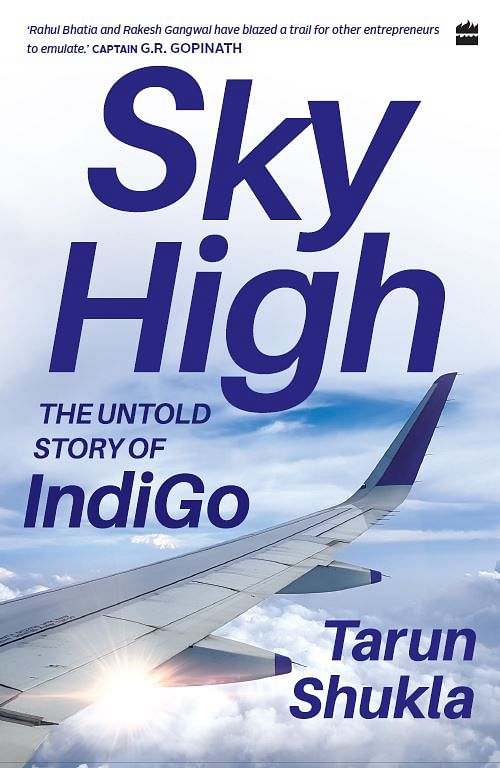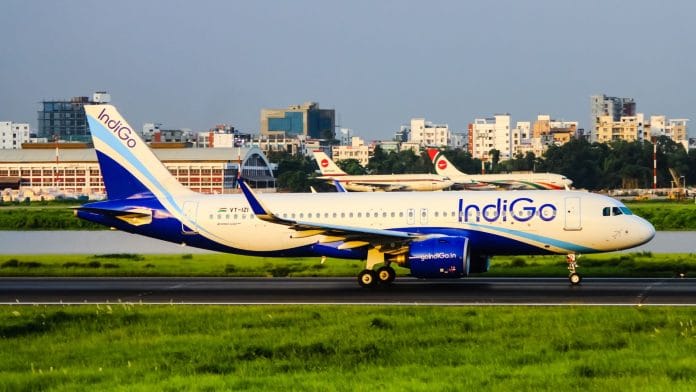IndiGo also tried to keep the messaging about pricing subtle. ‘We do not want to say “Fly on Rs 999 airfares”, which everyone was doing then. Instead, we said let’s first give them a reason to fly,’ Sunil continues, ‘Hence our messages were, “In-laws in town? IndiGo to Mummy.”’ The airline’s then-CEO Bruce Ashby had made it clear that pricing should be left alone; it should not scream; the focus should be to let people get a feel of what IndiGo is first.
Therefore, the first pre-launch copy read: ‘Announcing the arrival of IndiGo—India’s newest low fare airline. No frills. No fuss. No red tape. No silly excuses. No unnecessary delays. No long queues. No sulky faces. No pain.’
The first creative outdoor, when the airline launched, was also a simple teaser—the IndiGo’s dotted plane icon in the sky which said— ‘Ready for take-off’.
As new stations got added the lines kept changing—‘IndiGo to the City of Joy’, ‘IndiGo to Garden City’, ‘IndiGo to Bollywood’, ‘IndiGo to Capital’, ‘IndiGo to Anjuna’.
There were also some tweaks. When launching short-haul flights between Delhi and Jaipur, a route that had an efficient highway, IndiGo erected a hoarding on the highway that said: ‘Don’t Drive. Fly. Daily flights to Delhi.’
The next set of advertisements encouraged discretionary travel: ‘Stale fish in Delhi? IndiGo to Kolkata’; ‘Sweating in Delhi? IndiGo to Bangalore’; ‘Girlfriend in Delhi? IndiGo this weekend’; ‘Life getting you down? IndiGo to 35,000 feet’.
Once, IndiGo also placed a billboard outside Gurugram’s upmarket Golf Course road. It read ‘Sleep with your wife—same day return flights’. The airline wanted to test how the Golf Club-frequenting CEOs would react to it. ‘These are the guys who go to cocktail parties and start talking about it. How do you gauge it is working? Because people would call up and react,’ says Jayal. But it backfired elsewhere. Consumer complaints reached the Advertising Standards Council of India. The council ticked off the airline: ‘This will give a wrong message to the younger generation in particular, and public at large. This slogan is highly objectionable when read separately and can mean otherwise.’ It was pulled down.
Similarly, the airline placed another big hoarding at ITO in Delhi that showed a girl on a beach in a bikini, which read, ‘IndiGo to happiness. Daily flights to Goa. Book now.’ Apparently, it caused a traffic jam. But some people must have been offended. Letters started pouring in from women’s groups demanding removal of the hoarding stating, ‘You are promoting infidelity!’
In its early days, IndiGo never placed full-page advertisements in newspapers, although it was fashionable then to launch airlines with big front-page advertisements. Instead, IndiGo ran smaller advertisement on page three, or in the business section, because it felt marketing, sales, consulting and IT people fly the most.
IndiGo then rolled out some quirky recruitment advertisements. ‘Every supermodel’s favourite airline’. It showed only the model’s legs. The airline’s intention was to generate chatter in the market without spending too much. It tweaked its cabin crew hiring to look like matrimonial advertisements.
So, instead of saying, ‘Let your career take off’, it said, ‘Wanted tall slim girls for a young cool airline’ or even, ‘Call for Miss IndiGo’. Much like some of the best brands in the world, like Apple and Nike, where every single piece of communication passes through the top leadership, at IndiGo too, Rahul used to (and often still does) clear all the brand communications.
‘Rahul is very brand conscious,’ says Jayal. ‘He is a creative director in himself. He owns restaurants like China Club. He has a creative impulse. We would get a call at eight in the night saying he didn’t like the biscuit tin—‘mazaa nahin aaya’, and he and Sunil would be off in the morning looking at food items and designing tins.’
This drew some amount of ridicule. ‘Rahul sat with us on every little thing in the first couple of years of IndiGo. Other agencies told us we were spending time on stuff that people didn’t care about. We told them maybe you guys are right. Maybe we are wrong. But we just have to do it. And if Rahul and his team think it’s the right thing to do, it can’t be that crazy, they are not children,’ Jayal says, recalling conversations with his peers in advertising.
Airline promoters, often love being in the limelight and hobnobbing with celebrities. There are pictures of SpiceJet promoter Ajay Singh lying on the tarmac in front of a Boeing wearing his full business attire for a photo shoot.
Vijay Mallya was a Kingfisher brand ambassador himself, with Bollywood stars like Yana Gupta, Deepika Padukone and Katrina Kaif to help. Naresh Goyal was happy inviting and partying with the likes of Sridevi, Boney Kapoor, Shabana Azmi, Javed Akhtar, Shah Rukh Khan etc. at his home.
Rahul and Gangwal did not want any Bollywood in IndiGo. They themselves didn’t even want to be photographed—not then, not now. ‘We never pushed for an airline which is personality-based once we walked into a room with him,’ Jayal said, ‘Here the point is we can engineer something which works beautifully—tick-tock-tick-tock. It’s not about the man, it’s about what the man can produce. It’s the philosophy. It removes you from the product and that gives you the pride.’
While the brand was being built, Rahul was also pushing for a mascot for the airline. A blue box had IndiGo written on it, a special typeface, but Rahul wanted something as an identifier for the airline. Sunil was doodling something on a paper napkin while in discussions with Rahul. He drew this small plane and he looked at Jayal, and Rahul said, ‘Go for it.’ That simple dotted plane became to IndiGo what ‘Swoosh’ is to Nike.
When I asked Rahul about the dotted plane, he said it matched the airline’s philosophy because it connects the dots—it’s simple, almost childlike. The dotted plane was used to convey many meanings. In one of the early campaigns, an advertisement showed kids running on the beach, one faster than the others, and soon after the last kid came the dotted plane to convey the message of ‘Individuals on the go’.
The name IndiGo itself was coined by Rahul because he loved that colour. The G was capitalized because it also signifies ‘India on the Go’ and ‘Individuals on the Go.’ The dotted plane now appears on the belly of all IndiGo planes making it easily identifiable even when it is in air.
 This excerpt from ‘Sky High: The Untold Story of IndiGo’ by Tarun Shukla has been published with permission from HarperCollins Publishers.
This excerpt from ‘Sky High: The Untold Story of IndiGo’ by Tarun Shukla has been published with permission from HarperCollins Publishers.






